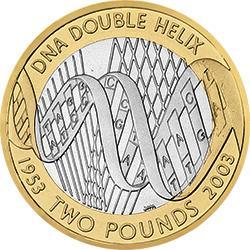The 2003 DNA £2 coin, or the double helix £2 coin, is very distinctive and stands out from the other coins in circulation. So, how much is it worth and how likely are you to find one in your change?
Well, according to average sold prices on eBay, the 2003 DNA £2 coin in circulated condition is worth around £3.20 plus the cost of postage. In this article we'll take a closer look at the history behind the coin, the design, the mintage and why it's worth more than face value.
What does the 2003 DNA £2 coin represent?
As we all know…..DNA is short for deoxyribonucleic acid and it is in every cell of every living thing. DNA is found in structures of the cell called chromosomes.
Francis Crick and James Watson are best known for their work at the Cavendish Laboratory at Cambridge University which led to the identification of the structure of DNA in 1953, drawing on the work of Maurice Wilkins and Rosalind Franklin amongst others.
Crick was one of Britain’s greatest scientists and Watson was an American geneticist and biophysicist and together, their discovery of the twisted molecular structure strand of deoxyribonucleic acid (DNA), the substance that is the basis of heredity, proved to be of enormous importance to biomedical research - and to life and health.
Watson saw that the essential DNA components—four organic bases—must be linked in definite pairs. This discovery was the key factor that enabled Watson and Crick to formulate a molecular model for DNA—a double helix, which can be likened to a spiralling staircase or a twisting ladder.
Although DNA had actually been discovered and isolated long before by Swiss biologist Friedrich Miescher in 1869, it was Francis Crick and James Watson, with the help of data acquired by an X-Ray Physicist Raymond Gosling. who first discovered the molecular structure and identified it. The two noticed a twisted strand of DNA that was intertwined in such a way that it was able to pull apart, replicate itself, and pass their genetic code from old cells to new ones.
Design of the coin
The coin's reverse design pays tribute to this 'double helix' structure and marks the 50th anniversary of its momentous discovery.
It is designed by John Mills, who has also designed other coins for the Royal Mint, including the 1994 D Day Landings 50p and the 1998 EU Stars 50p.

The letters A C G and T are on the strands of chromosomes and repeated across the coin’s reverse. The letters represent the four building blocks (Adenine, Cytosine, Guanine, and Thymine) that form amino acids and create protein.
You will see on the reverse that Adenine pairs with Thymine, represented by A and T being on the same strand, and Cytosine pairs with Guanine, shown with C and G on the same strand.
From left to right, and top to bottom the letters can be read as TAGGCCTAACT on top and ATCCGAATTGA on the bottom, as a double helix curves across the coin.
The initials of the designer John Mills, JM, can be seen above the letters U and N in the words 'TWO POUNDS' at the bottom of the outer circle.
On the outer circle at the top of the coin, above the DNA molecule, are the words DNA DOUBLE HELIX. Just below, are the dates 1953 and 2003 on either side of the words TWO POUNDS to represent the 50th anniversary of this scientific discovery.
The inscription 'DEOXYRIBONUCLEIC ACID' is incused on the milled edge of the coin.
The Obverse shows the Fourth Portrait of Queen Elizabeth II, designed by Ian Rank Broadley, FRBS, FSNAD, whose initials IRB appear under the head, as used on all British coins from 1998.

The legend (inscription) reads: ELIZABETH · II · D · G · REG · FID · DEF · TWO POUNDS.
Mintage of the Coin
With a mintage of 4,299,000, the DNA £2 Coin is of similar mintage to 2016 Shakespeare Comedies £2 coin (4.355,000) and 2001 Marconi £2 coin (4,558,000).
Although a mintage of about 4.3 million for a £2 coin is not all that low, given that the coin has been in use for more than 19 years, it is possible that many of them have been saved or thrown away over that time so the coin may be far scarcer.
The same year saw the introduction of the Suffragettes 50p coin and also a standard technology £2 coin.
How rare is the DNA £2 coin?
For context, the mintage of some of the rarest £2 coins, such the £2 Olympic Games Handover or the £2 Commonwealth Games Ireland coins, is well below one million.
This 2003 £2 coin from isn't very rare, but the average sold prices on eBay show that there is still buyers out there who want to add it to their collection.
Although 4,299,000 of the coins entered circulation, there were other versions that were produced by the Royal Mint.
A total of 41,568 brilliant uncirculated versions of this coin were issued in a presentation card, 25,000 Silver Proofs were issued in a special presentation box and certificate of authenticity, 10,000 Silver Proof Piedforts which are double the weight of the Silver Proofs and finally 1,500 Gold Proof versions where the whole of the coin has a gold colour design.
How much is the DNA Two Pound coin worth?
The coin is actually worth the same as the common circulating version, or about £3.40 without shipping, because the Royal Mint has confirmed that there aren't any error versions of the coin.
Where can I buy the 2003 DNA £2 Coin?
You can purchase the coin here from our site.
You can buy the circulated version of the DNA £2 coin online on auction sites such as eBay or Amazon but please ensure you look at all the information and reputation of the seller.
As we said we expect this coin to be selling for around £3 plus postage so be wary of any listings trying to sell this circulated coin for more than £10.
Unfortunately, as this coin is now over 19 years old, the Royal Mint no longer stock this coin so it is only available to buy on the secondary market.
Are there any known errors of this coin?
There are no known errors of this coin so please be wary of sellers listing these coins at overstated prices, with 'errors'.
Bit of trivia...
A human's DNA could stretch from the earth to the sun and back ~600 times. If unwound and linked together, the strands of DNA in each of your cells would be 6 feet long. With 100 trillion cells in your body, that means if all your DNA were put end-to-end, it would stretch over 110 billion miles. That’s hundreds of round trips to the sun!
The human genome contains 3 billion base pairs of DNA but we’re all 99.9 percent alike. Of the 3 billion base pairs in the human genome, only 0.1% are unique to us. While that 0.1% is still what makes us unique, it means we’re all more similar than we are different. Weird!

